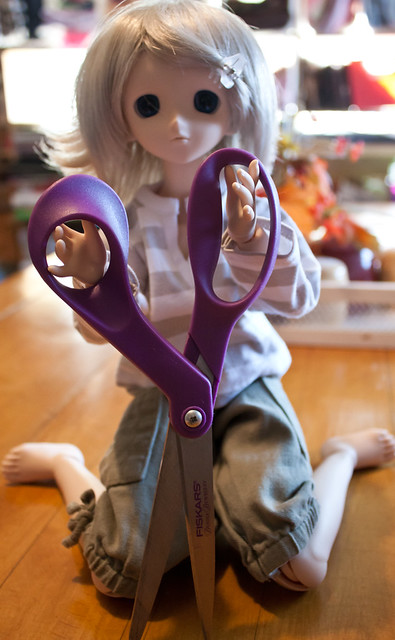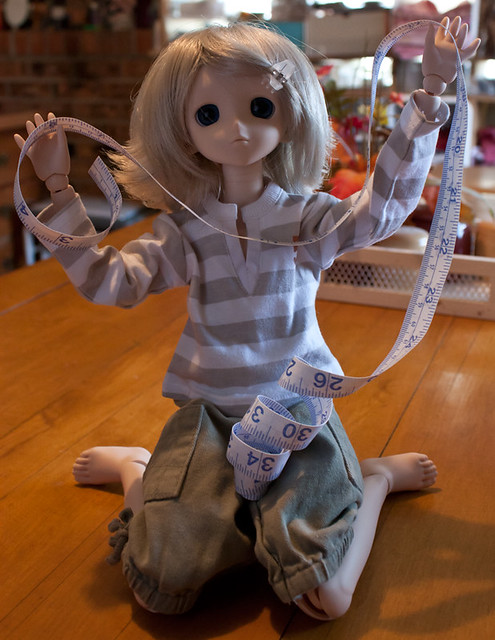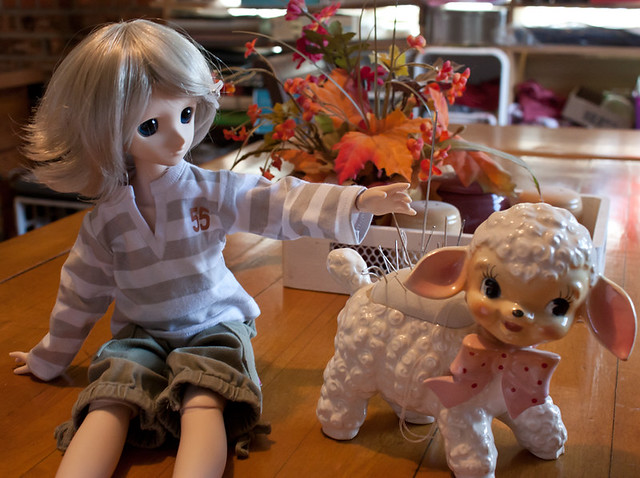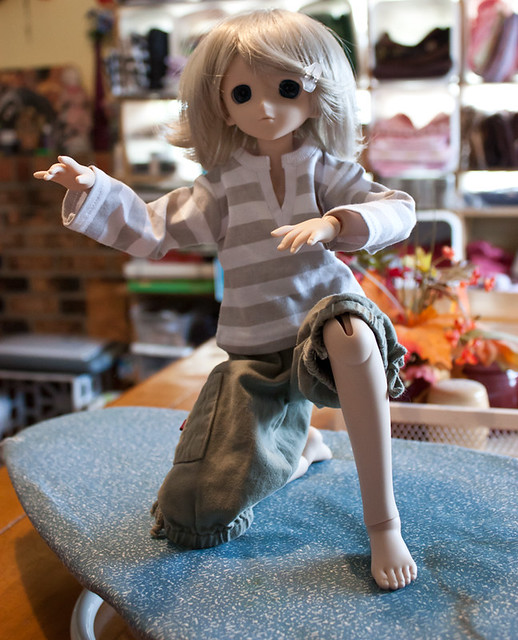Going to a fabric store can be a fun
experience, so much color everywhere, tons of nifty gadgets, walls of
buttons... enough visual chaos to make you want to go running out of the
store like a lunatic with their hair on fire. I've seen this plenty
enough with my husband when he has accompanied me to our local Joann's
store. I'm sure it didn't help him any that I knew what I was looking
for and needed very little input from him.
{ Sisterly Tip }If you are afraid of being overwhelmed while in the store, plan ahead and don't go on the weekend if you have a choice. That is when they are normally the most busy, especially Saturday and Sunday afternoon, and if there is a sale that weekend, it won't be pretty. You know scene in the old movies, the camera pans slowly over the clothing department of a quiet store. Out of the blue, a voice calmly in forms the customers of a spontaneous sale. The sudden announcement causes the customers to come out of the woodwork in a frenzy, grabbing at anything they can? Yah, it can feel like that.
 |
| "Too big for Tamayuki!" |
► Scissors: Having sharp scissors is absolutely mandatory. Otherwise your fabric will not cut well or straight, nicks in the blades will leave threads uncut and snag the fabric,
making your project miserable before it is hardly started. I have bought
good sewing scissors from fabric stores as well as from mega stores,
both kinds were sharp and cut well. The biggest factor in good scissors
is how they are treated, making sure that they don't get nicked by
accidentally trying to cut through a pin. Been there, done that. Also, don't let anyone use them, period.
Put a label on them, hide them, lock them up. No one cares about your
sewing scissors as well as you do, I had to fight for years against my
family and my husband to simply leave them alone. I wouldn't be so
adamant about this because cotton fabric tolerates a lot, but silk,
tulle, or even just simple jersey fabric will be difficult to cut with nicked or even dull scissors.
Special note: If you are left-handed, make sure you buy left-handed sewing scissors like the 'Classic Lefty' Fiskars Bent Multi-Purpose Scissors.
 |
| "If I had my own room I could make the walls pretty with this!" |
► Tape Measure:
Any tape measure will do but it would be much better to have one that
includes both inches and centimeters for accuracy. I also have one with
yardage marks that I find really useful, but I also sew full sized
clothes frequently.
 |
| "Is this a slide ruler mommy?" |
► Hem Guage:
This is particularly useful for working on small scale clothing
projects because you can set the measurement you need, saving a lot of
time. I use mine most often to avoid having to pin skirt hems, quickly
and accurately, measuring the hem as I'm ironing. Any time saved from having to pin is worth it.
 |
| "Ouchie sheep isn't ouchie because he has lots of wool." |
► Pin Cushion: I mainly use the pin cushion for my hand sewing needles,
especially the specialty ones, like my curved needles, or my hugely long
doll needle, or even the really tiny ones that can get lost in the
blink of an eye. Just a normal pin cushion
will work, but you can also use a cute vase or maybe one of those old
character face mugs that have a hat and convert it into a decorative and
functional needle holder!
► Hand Sewing Needles: This is mostly important for those times when you need to secure threads when you didn't have room to reverse stitch to lock in the threads or it would have made the garment look ugly, or hand sewing an elastic casing closed. Usually you can find multi-packs of hand sewing needles inexpensively, but be careful to not get cheap quality ones. I've done this before and the entire pack of needles had rust spots where they were poked through the paper that held them. No amount of sanding made them work smoothly because the rust would catch on the fabric.
► Hand Sewing Needles: This is mostly important for those times when you need to secure threads when you didn't have room to reverse stitch to lock in the threads or it would have made the garment look ugly, or hand sewing an elastic casing closed. Usually you can find multi-packs of hand sewing needles inexpensively, but be careful to not get cheap quality ones. I've done this before and the entire pack of needles had rust spots where they were poked through the paper that held them. No amount of sanding made them work smoothly because the rust would catch on the fabric.
 |
| "Mommy forgot to put these pins away. I'm a big boy so I can do it for her." |
► Sewing Pins: Always buy good quality sewing pins.
A time or two many years ago I bought a cheap/off brand of pins. Big
mistake. Many of the pins were not smooth, some would snag my fabric,
others wouldn't even be sharp enough to pin! My preferred kind of pins
are Dritz Quilting Pearl Head Pins 1-1/2",
but the one downside is the pin heads are plastic and can melt on my
iron if I'm not careful. The other option is to get glass head pins or Dritz no-melt flat head pins
that wouldn't be affected by the heat. Another bonus of the flat head
pins is if you have large or bulky fingers (like my husband's), it will
give you a more room to grab onto the pins.
► Metal Container For Pins & A Strong Magnet: Buy sewing supplies and get candy! Sounds like a deal to me. Kidding aside, having a metal container, to not only store your pins in, but also with the handy magnet to grab the pins as they are pulled from fabric as you sew, really saves a lot of time. Plus if you drop a pin or needle on the floor or carpet, just take the magnet off the top of your pin container to retrieve the runaway. I have used mine this way for years and it works great as long as the magnet is strong enough to stick to the top of the tin as well as hold a small bunch of pins. The magnet I use is like these ones, but mostly because they were given to my husband as a gift so we had them around, but any good magnet will work.
► Metal Container For Pins & A Strong Magnet: Buy sewing supplies and get candy! Sounds like a deal to me. Kidding aside, having a metal container, to not only store your pins in, but also with the handy magnet to grab the pins as they are pulled from fabric as you sew, really saves a lot of time. Plus if you drop a pin or needle on the floor or carpet, just take the magnet off the top of your pin container to retrieve the runaway. I have used mine this way for years and it works great as long as the magnet is strong enough to stick to the top of the tin as well as hold a small bunch of pins. The magnet I use is like these ones, but mostly because they were given to my husband as a gift so we had them around, but any good magnet will work.
 |
| "I want this one, and this one, and this one..." |
► Thread:
Again, this is another item where you don't want to buy the cheapest
because the possibility that it will be nothing but a headache is pretty
high. I still have some store brand black thread around here that I
bought at Walmart many years ago. The thread isn't coated, the thickness
is uneven and has lumps in it, I hate using it even for just hand
sewing but using it in my sewing machine it constantly breaks because it
gets too thin to withstand the tension, or the lumps get stuck in the
eye of the needle and break. Avoid the frustration by sticking with
Coats & Clark or the other better quality thread makers. When the
thread is the only thing holding your sewing together, you want to use
thread that you know will do it's job well.
 |
| "Dinorawrs are the best to snuggle, even when there are kitties!" |
► Fabric:
This one is a no-brainer, right? Well, mostly. It's true that you can
use any fabric to sew, but even some of the ultra fancy fabrics can be a
challenge for even a more experienced seamstress. To start with, stick
with basic cotton, it comes in tons of solid colors (broadcloth) and a
huge variety of prints because it is the most common fabric used in
quilting or general sewing. It really is the easiest to work with and
behaves nicely as long as it is 100% cotton and not a strange
cotton/polyester blend. I point this out because my husband bought me
some fabric many years ago as a present. Initially it seemed like really
nice maroon broadcloth, but after further inspection (and multiple
washings of the skirt I eventually made) it doesn't act much like
cotton. It is a complete lint magnet, and wrinkles if you look at it
wrong. I love the skirt, but it is a lot more fussy than pure cotton
broadcloth would have been. I'll talk more about fabric in another post, because it is such an extensive subject.
 |
| "I will use this to sneak olives from the can when mommy isn't looking. He he he." |
► Seam Ripper:
Seam rippers are easy to find and as long as they are sharp they should
work just fine. If you have to saw through your threads, it's time for a
new one. I have found that if you spend a lot of time pulling out seams
(I do a lot to disassemble old clothing that can be re-purposed) then
getting a long handled seam ripper like this one saves hands from cramping trying to use a small one for an extended amount of time.
 |
| "Look mommy, I'm ironing! Don't worry, it's not plugged in." |
► Iron:
Another one that is pretty simple, the only reason I'm pointing it out
is just for an FYI. Sewing always requires ironing at some point, but
not all irons are equal when it comes to sewing, most especially when
you are using fusible interfacing. The problem with interfacing and
steam irons is the indents on the sole plate where the steam spews out,
it leaves those same indents on the fused fabric/interfacing or tissue
paper/interfacing, looking like half deflated bubblewrap that you can't
quite get rid of. Very annoying. Last year I finally tracked down a dry iron,
an iron that has a smooth sole plate and doesn't steam, perfect for
interfacing. If you need to steam the fabric, have a squirt bottle
nearby, simple as that. These kind of irons used to be called sad-irons,
not because they were depressed, but because sad was an old term for solid or heavy. Either way, they are still really useful and I prefer my dry iron to my steam iron.
 |
| "I'm a beach boy, surfing on your ironing board!" |
► Ironing board:
The kind of ironing board you choose depends on personal preference as
well as space available. There are table top ironing boards, ones that
hang from the back of a door, standard floor ironing boards, or even
just a towel on top of an electric dryer. Personally I like 'the floor
model' because it doesn't take up table space and the height is
adjustable to use sitting or standing. Arguably you could say that for
the table top kind, but only if your table is the right height and the
chair you are using, or if you are short... None the less, having
something to iron on that won't stain the fabric, warp from the
heat/moisture, and won't catch on fire is important.
 |
| "It's little, just like me!" |
► Safety Pins:
Generally I find a single use for these that makes them invaluable in
making doll clothes. Because the casing for elastic is usually very
narrow, gold safety pins are about the only thing I have found that
makes it easy to thread elastic into a waistband. Why gold? Usually when
you buy a multi-pack of randomly sized safety pins, the smallest size
is colored gold to stand out against the rest of the silver pins. They
are usually 3/4in (2cm) long by less than 1/4in (1/2cm) wide. It is amazing what you find when you take the time to search for things! I never knew that you could buy these size safety pins separately. XD Well, that will make things easier especially since you normally only got about four of them in the multi-packs.
The only two things not covered by this list is a sewing machine, and fasteners. I have only used four sewing machines in the twenty years I have been sewing so I don't particularly feel like I have a broad enough experience to say what works best for most beginners. I can make a separate post talking in depth about my current sewing machine and my thoughts on it if there is enough interest. This would give you an idea of the kind of things to look for or think about before buying one. Fasteners really depend on what is required for the specific project you are working on, but also your personal preference for the types you most often use. This will have a separate post because each kind has it's own pros and cons.
Hopefully this list makes it less of an overwhelming experience when you venture into the fabric store. Seeing so many gadgets and strange looking implements can be exciting, but if you don't know what you are looking for, it can a frustrating task. Now venture forth, and don't tell them Sister Kyoya sent you, because they would have no idea who I am.
The only two things not covered by this list is a sewing machine, and fasteners. I have only used four sewing machines in the twenty years I have been sewing so I don't particularly feel like I have a broad enough experience to say what works best for most beginners. I can make a separate post talking in depth about my current sewing machine and my thoughts on it if there is enough interest. This would give you an idea of the kind of things to look for or think about before buying one. Fasteners really depend on what is required for the specific project you are working on, but also your personal preference for the types you most often use. This will have a separate post because each kind has it's own pros and cons.
Hopefully this list makes it less of an overwhelming experience when you venture into the fabric store. Seeing so many gadgets and strange looking implements can be exciting, but if you don't know what you are looking for, it can a frustrating task. Now venture forth, and don't tell them Sister Kyoya sent you, because they would have no idea who I am.
~Sister Kyoya
No comments:
Post a Comment